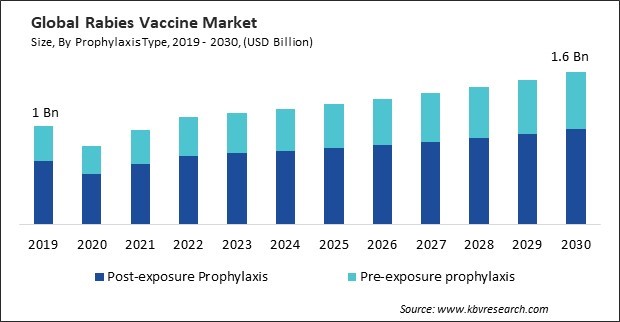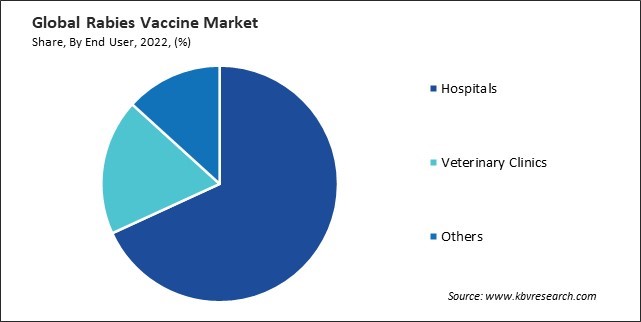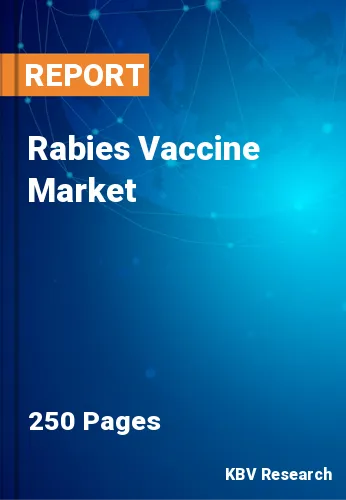“Global Rabies Vaccine Market to reach a market value of USD 1.6 Billion by 2030 growing at a CAGR of 4.5%”
The Global Rabies Vaccine Market size is expected to reach $1.6 billion by 2030, rising at a market growth of 4.5% CAGR during the forecast period.
Pet owners increasingly adopt preventive healthcare practices for their animals, mirroring trends in human healthcare. Regular veterinary visits, including vaccinations, are proactive measures to protect pets from diseases such as rabies, fostering a continuous demand for vaccines. Consequently, the Veterinary clinics segment would acquire nearly, 20% market share by 2030. Advancements in veterinary medicine, including the availability of improved and safer vaccines, contribute to a positive perception of vaccinations among pet owners.

Ongoing R&D activities focus on improving the formulation of these vaccines. Researchers work to enhance vaccine stability, reduce adverse reactions, and optimize the immune response. R&D efforts aim to develop next-generation vaccines with enhanced characteristics. This may include vaccines with longer-lasting immunity, novel delivery methods, and the ability to protect against a broader spectrum of rabies virus variants. Therefore, the market is expanding significantly due to the rising research and development (R&D) initiatives. Additionally, Rabies poses a severe threat to human health as it can be transmitted through the saliva of infected animals, primarily through bites or scratches. Zoonotic diseases often transcend national borders, necessitating global collaboration. Collaborative efforts and funding support facilitate the implementation of vaccination programs to control and eliminate rabies, particularly in regions where the disease poses a significant zoonotic threat. Hence, increasing awareness of zoonotic diseases like rabies has been a pivotal factor in driving the growth of the market.
Moreover, The COVID-19 pandemic disrupted routine healthcare services, including vaccination programs. Lockdowns, restrictions on movement, and healthcare system strain may affect the implementation of rabies vaccination campaigns, particularly in regions with limited resources. Travel restrictions and disruptions in global transportation may affected the movement of professionals involved in global health initiatives and collaborations. This impact global efforts to control and eliminate rabies. Thus, the COVID-19 pandemic had a moderate effect on the market.
However, High vaccination program costs can restrict access to these vaccines, particularly in resource-constrained areas. Governments responsible for public health initiatives may experience financial strain when implementing rabies vaccination programs. The allocation of resources to these programs may compete with other essential healthcare needs, potentially leading to budget constraints. Thus, high cost can slow down the growth of the market.
Based on prophylaxis type, the market is classified into pre-exposure prophylaxis and post-exposure prophylaxis. The pre-exposure prophylaxis segment acquired a 40% revenue share in the market in 2022. Pre-exposure prophylaxis offers long-term protection, reducing the need for immediate post-exposure treatment for potential rabies exposure. This long-term protection can be cost-effective in the long run, considering the expenses associated with post-exposure prophylaxis.
Based on end user, the market is segmented into hospitals, veterinary clinics, and others. The veterinary clinics segment recorded a 20% revenue share in the market in 2022. A greater demand for veterinary services, such as rabies vaccination, has resulted from the global rise in the prevalence of pet ownership. Routine vaccination programs are integral to the preventive healthcare veterinary clinics provide to pets, including dogs and cats.

On the basis of application, the market is bifurcated into human and animal. The animal segment garnered a 30% revenue share in the market in 2022. Animals, particularly mammals, serve as the primary reservoirs of the rabies virus. Controlling rabies in animal populations is essential to reduce the risk of transmission to humans through bites or scratches.
By product type, the market is categorized into chick embryo cells rabies vaccine, Vero cell rabies vaccine, human diploid cell vaccine, and others. The Vero cell rabies vaccine segment covered a 20% revenue share in the market in 2022. The Vero cell vaccine eliminates the use of nervous tissue in its production, addressing safety concerns associated with traditional nerve tissue-derived vaccines. Removing nervous tissue reduces the risk of adverse reactions, making the Vero cell vaccine a safer option for rabies prevention.
Free Valuable Insights: Global Rabies Vaccine Market size to reach USD 1.6 Billion by 2030
Region-wise, the market is analysed across North America, Europe, Asia Pacific, and LAMEA. In 2022, the North America region led the market by generating 40% revenue share. North America's health authorities and veterinary services implement strategic vaccination programs targeting domestic and wildlife populations. Veterinary clinics and practices across North America actively participate in rabies prevention by providing pet vaccination services.
| Report Attribute | Details |
|---|---|
| Market size value in 2022 | USD 1.1 Billion |
| Market size forecast in 2030 | USD 1.6 Billion |
| Base Year | 2022 |
| Historical Period | 2019 to 2021 |
| Forecast Period | 2023 to 2030 |
| Revenue Growth Rate | CAGR of 4.5% from 2023 to 2030 |
| Number of Pages | 250 |
| Number of Tables | 430 |
| Report coverage | Market Trends, Revenue Estimation and Forecast, Segmentation Analysis, Regional and Country Breakdown, Porter’s 5 Forces Analysis, Company Profiling, Companies Strategic Developments, SWOT Analysis, Winning Imperatives |
| Segments covered | Product Type, Prophylaxis Type, Application, End User, Region |
| Country scope |
|
| Companies Included | Boehringer Ingelheim International GmbH, Cadila Pharmaceuticals Limited, Serum Institute of India Pvt. Ltd. (Cyrus Poonawalla Group), Elanco Animal Health, Inc., Zoetis, Inc., Merck & Co., Inc., Novartis AG, Bharat Biotech Ltd., Sanofi S.A. and Virbac |
By Prophylaxis Type
By End User
By Application
By Product Type
By Geography
This Market size is expected to reach $1.6 billion by 2030.
Rising research and development (R&D) initiatives are driving the Market in coming years, however, High cost of vaccination programs restraints the growth of the Market.
Boehringer Ingelheim International GmbH, Cadila Pharmaceuticals Limited, Serum Institute of India Pvt. Ltd. (Cyrus Poonawalla Group), Elanco Animal Health, Inc., Zoetis, Inc., Merck & Co., Inc., Novartis AG, Bharat Biotech Ltd., Sanofi S.A. and Virbac
The expected CAGR of this Market is 4.5% from 2023 to 2030.
The Post-exposure Prophylaxis segment is generating the highest revenue in the Market by Prophylaxis Type in 2022; there by, achieving a market value of $995.7 Million by 2030.
The North America region dominated the Market by Region in 2022, and would continue to be a dominant market till 2030; there by, achieving a market value of $543.1 Million by 2030.
Our team of dedicated experts can provide you with attractive expansion opportunities for your business.

 Drivers
Drivers
 Restraints
Restraints
 Opportunities
Opportunities
 Challenges
Challenges
